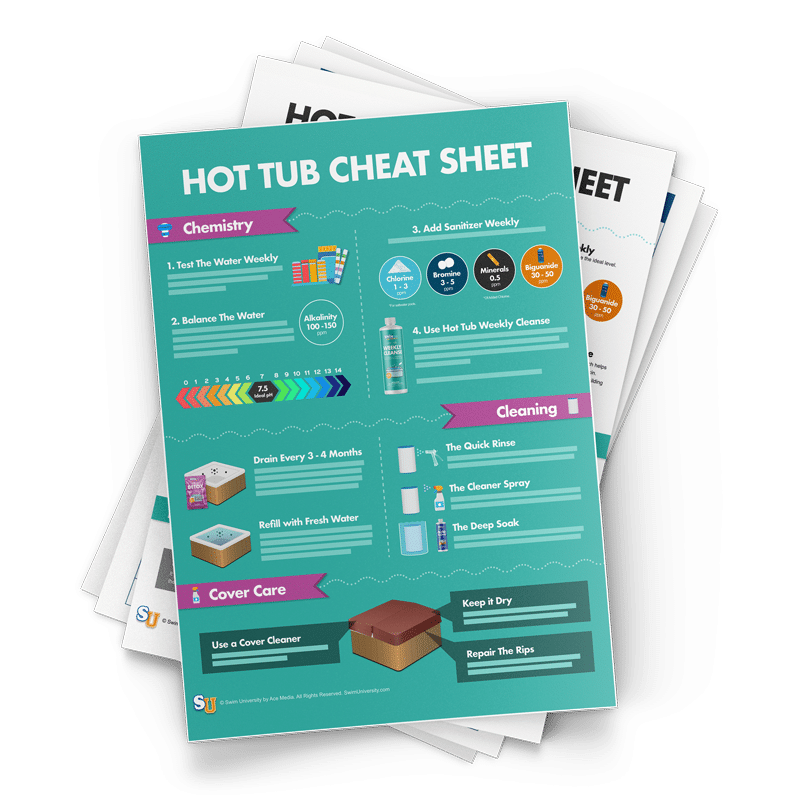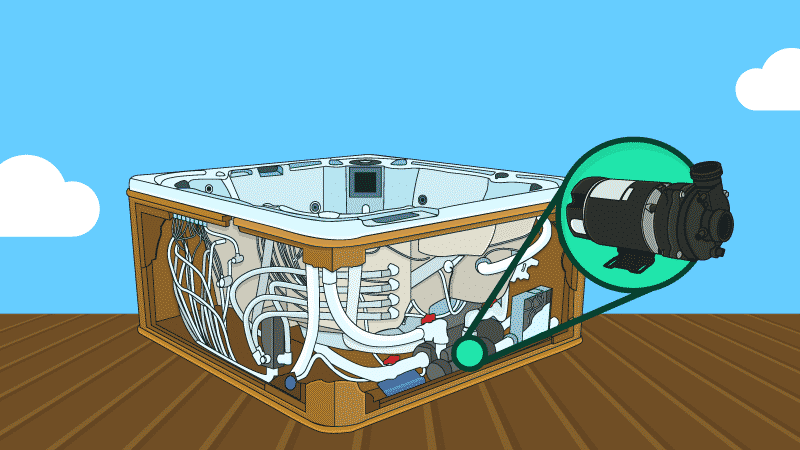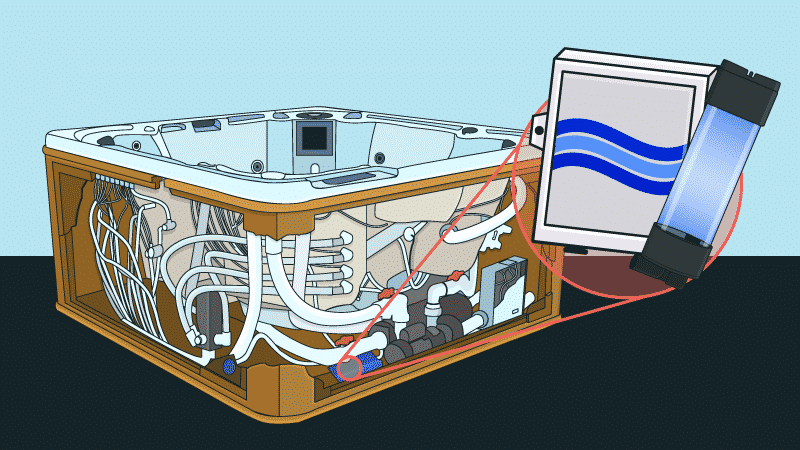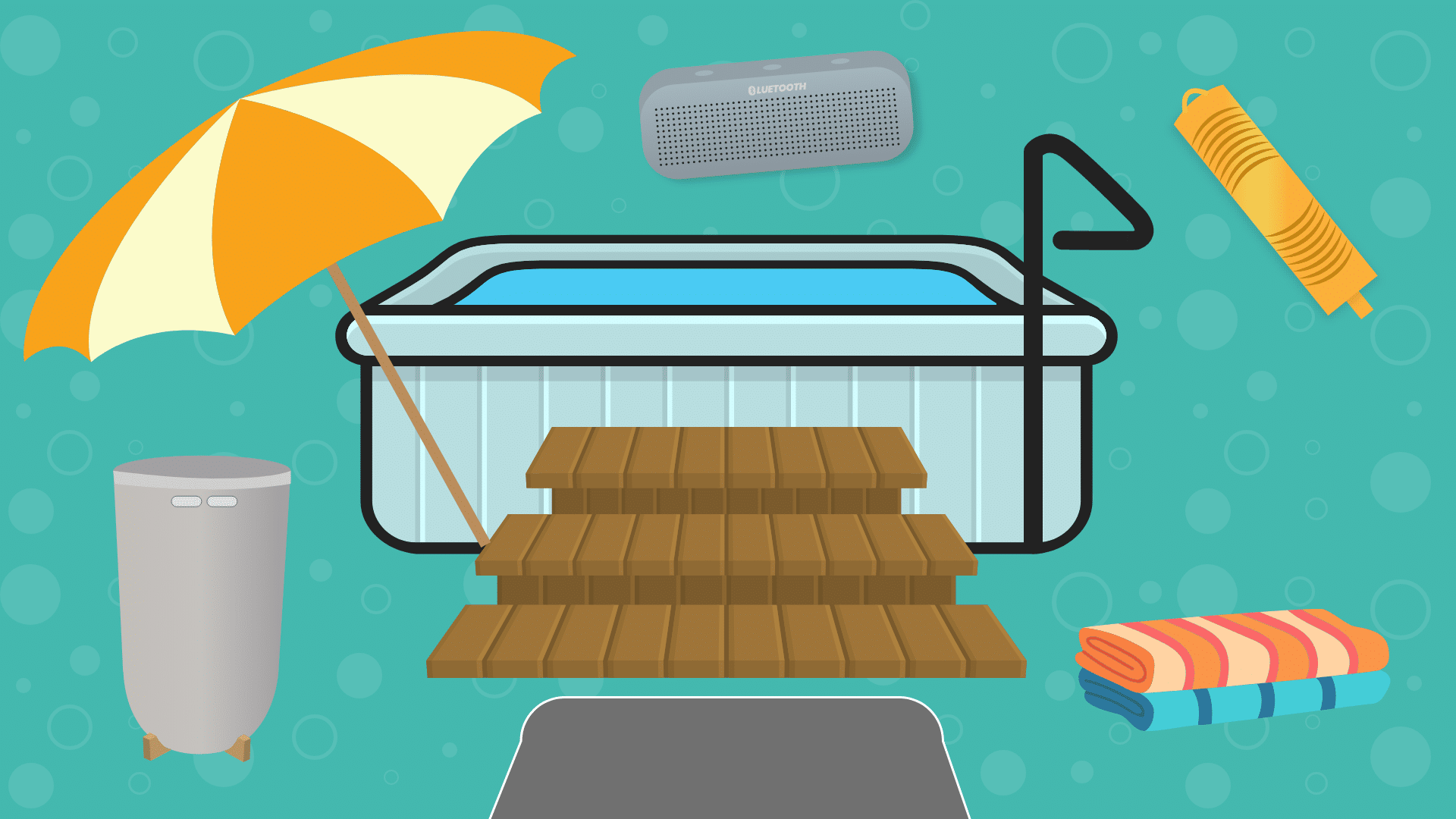The Complete Guide to Hot Tub Heaters
Whether you’re a new hot tub owner or a spa master, your first priority after starting a hot tub is probably going to be how to heat a hot tub. After all, a hot tub with no heat is just a tub. How you heat it depends on your hot tub’s condition, efficiency, and location.
Good things may come to those who wait, but we say it’s no fun waiting longer than necessary. Every hot tub is different, but you can find ways to get your tub a-bubblin’ quickly with the right hot tub heater, and then regular maintenance and a few strategic upgrades.
Learn how to keep your hot tub clear while saving money so you can enjoy more soaking time without big costs. The Hot Tub Handbook covers every type of hot tub on earth.
Wait, I Can Replace My Hot Tub Heater?
Yes! While all spas come with a heater installed, it’s a component that can be replaced when necessary, or upgraded when desired. It’d be ridiculous if you had to get a new hot tub every time the heater went out.
Sometimes, it’s sort of like the stock stereo that comes with a new car. It works and it sounds OK. But you can upgrade to something that rocks your car on its tires.
Upgrading your hot tub heater can mean your water heats up more quickly, and that the heater itself works more efficiently, thereby using less energy and costing you less money.
Factors That Can Affect Hot Tub Heating Efficiency
Your hot tub might heat up more or less quickly depending on a number of factors, including:
- Ambient temperature, or the temperature where your hot tub is located
- hot tub cover placement (on/off, secure/loose)
- Condition of your hot tub’s hardware
Ambient Temperature
The warmer the water and surrounding air, the less time your hot tub will need to heat to the proper temperature. What’s the proper temperature? For adults, health experts suggest that 104°F (40°C) is the upper limit for hot tub temperature. You’ll probably find your spa is most comfortable somewhere between 100°F (38°C) and 102°F (39°C).
For example, let’s say it’s 76°F (24°C) outside, and your water is at the same temperature. Heating your hot tub to 100°F (38°C) will take 4 to 8 hours. If, on the other hand, it’s a frosty 52°F (11°C) outside, and your water is the same temperature, it’ll need 8 to 16 hours to reach 100°F (38°C).
ProTip: As the temperature climbs, monitor it with a floating spa thermometer. Compare the readings with your system temperature to make sure the thermometer built into your hot tub control panel works properly.
Finally, an Easy Way to Read Your Water Temperature from Both Indoors and Outdoors
Cover Placement
Another way to speed up your hot tub heating is to leave the hot tub cover on while you wait.
Most of the heat lost from your hot tub disappears into the air above it. Leaving the cover in place traps heat and helps warm things up more quickly.
ProTip: An old, damaged cover can reduce efficiency and harbor all sorts of funky grime and microbes. If yours has seen better days, consider replacing it to improve not just your hot tub’s heating efficiency, but the overall health and safety of your spa.
All custom spa covers are made to order with the exact measurements provided to ensure a perfect fit. They utilize the highest quality marine grade vinyl and insulation that sets their covers apart in the industry.
Hardware
A malfunctioning hot tub heater or pump, or defective jets can throw a monkey wrench into your plans for a relaxing soak. Regular hot tub maintenance helps keep everything working at peak efficiency.
How to Heat a Hot Tub Even More Efficiently
Beyond leaving your cover on and performing regular maintenance, you can help your hot tub heat up more quickly with a few upgrades to your spa and its surroundings.
Warm Up to Spa Landscaping
It can be all too easy to overlook the importance of not just beautiful but functional landscaping when you’re setting up your hot tub. In addition to keeping heat in, you can help keep cold out by blocking wind and weather from your hot tub.
Wind can increase evaporation and cooling, making your hot tub work harder to reach the right temperature, and maintain it once it’s reached. Planting trees in your yard can cut wind considerably. You can also make a smaller, more localized windbreak around your hot tub area by planting shrubs. Single, double, or even triple rows of the right plants will cut noise and precipitation as well as excess wind. They’ll also provide more privacy, not to mention beauty.
You can also install special screens around your hot tub to block the wind and help keep your hot tub warmer longer. Like landscaping, these panels help keep your hot tub more private and comfortable, too.
This awning offers a versatile mix of elegance and practicality, serving as a shade, divider, or privacy screen for both residential and commercial spaces.
Improve Your Hot Tub’s Insulation
While the bulk of heat is lost from your hot tub through the open surface of the water, you might also be losing some heat due to tiny leaks in the cabinet.
Bulking up the insulation can help keep cold air out, making it easier to heat your spa. It will also help keep it warm, so you won’t need as much time or energy to bring your hot tub to the right temperature if you haven’t used it in a few days.
You can install wall or attic insulation on the inside of your hot tub cabinet panels to boost warming power. Or, if you’re more of a DIYer, you can build a cabinet surround—basically, a cabinet for your cabinet—and fill it with insulation.
Power Up the Cover
Trapping ambient heat and reducing evaporation by leaving a well-maintained hot tub cover in place while you heat your spa is a good start. But if you’re looking for Buster Poindexter levels of hot, hot, hot, consider adding a floating spa cover in addition to your main hot tub cover.
Adding a blanket cover can boost your spa’s R-value, or insulation efficiency rating, by nearly a third. That means less heat loss, and faster heating when you’re ready for some tubbin’.
A great cover to help keep the water warm. Using it regularly also helps maintain your water chemistry levels. Our solar blanket covers are made from a lightweight, yet durable polyethylene material. They are easy to install by cutting the cover to the shape of your spa or hot tub with scissors if it is irregularly shaped.
Should You Leave Your Hot Tub Running?
The answer to this question depends on how and when you use your spa.
If you live in a colder climate and you like to use your hot tub a few times a week, you’ll save time and money by leaving it running, and keeping the hot tub heater on. You won’t have to use extra energy or wait for hours and hours to heat things up whenever you want to take a soak.
On the other hand, if the climate is milder in your area, and you only use your hot tub occasionally, shutting it down between uses makes sense.
If you have sub-zero winters where you live, and your hot tub is outside, you’ll have a different choice to make. If you plan on hot tubbing while the snow flies, you’ll definitely need to keep your hot tub running all winter.
If you’re not a member of the Polar Bear Club and are more worried about hot cocoa than a hot soak, you’ll need to know how to winterize your hot tub.
How to Troubleshoot a Hot Tub Heater
There are few things worse than stepping into a cold hot tub. If your hot tub isn’t heating properly, you’re likely experiencing one of three symptoms.
The Hot Tub Isn’t Staying Hot
If your hot tub heats up with no problem, but then seems to just fizzle out and cool just like a regular bath, the first thing to check is the filter to make sure it’s not clogged. If you do find debris, clear it out, and then give the filter a good cleaning.
If the filter’s not the problem, check the thermostat and heat sensors. Electrical components can sometimes burn out or go bad, and will need to be replaced.
Finally, check the spa’s circulation. If the plumbing is clogged, and the water can’t circulate properly, it will begin to gradually cool down after it’s heated. If this is the case, you’ll need to drain and clean the hot tub, and use a line flush product to clear the plumbing.
Don't let your hot tub fill with hard-to-remove gunk. Clear out the gunk and keep your hot tub water fresh. It removes gunk in your pipes caused by lotions, sunscreens, cosmetics, etc.
The Hot Tub Temperature Fluctuates
This can be a difficult problem to identify because it fools you into thinking nothing’s wrong.
You turn on your hot tub and slide into nice, warm water. Five minutes later, you’re shivering because the temperature has dropped even though you haven’t touched the controls.
But then it heats up again, so you figure it was a fluke and go on about your soak until the water becomes so hot, you feel like you’re stew on the dinner menu.
Fluctuating temperatures are most often caused by a temperature sensor that has started to die. If the sensor is in good working order, it may be the thermostat or heat sensors.
Whichever of those three things is the problem, it’ll have to be replaced.
The Hot Tub Isn’t Heating at All
You turn on your hot tub, wait a little while for it to heat up, then step into ice-cold or at least room-temperature water. Yikes! Oddly enough, this can be caused by low flow from your hot tub pump. If that’s the problem, you’ll have to replace the pump.
The lack of heat may also be due to a bad heating element. When a heating element goes bad, there’s no fixing it. You’ll have to replace it. Luckily, heating elements aren’t expensive, and aren’t too difficult to replace.
Understanding the Heating Element Assembly
In a typical hot tub, the heating element is contained within the heater assembly housing. This housing exchanges the heat produced by the heating element to the water as it flows through the tube.
Some heating assemblies also use sensors such as a thermostat to control the temperature, and a high limit switch to keep the water from becoming too hot.
How to Replace the Heating Element
Replacing the element in your hot tub heater is easier than you may think.
Important: Before you begin any kind of work on your hot tub, disconnect all power leading to it.
- Locate the heating element assembly inside your hot tub cabinet.
- Disconnect the electrical wires.
- Remove the heating element.
- Place the new heating element in the now-empty space.
- Reconnect the electrical wires.
- Test the element by setting your hot tub to the usual soaking temperature, and waiting the appropriate amount of time for it to heat up, depending on current water temperature, and ambient temperature.
Keep the Heater Element from Going Bad
You can save yourself some money and time by keeping your hot tub heater element in good condition with regular maintenance.
Keep the Water Balanced
Balanced water chemistry can help prevent corrosion inside your hot tub and extend the life of the heating element and the hot tub heater in general.
Keep Air Out of the System
After every maintenance session, be sure to flush all the air out of the system. Air in the lines can lead to the heating assembly’s premature failure.
Clean the Filter Regularly
Clogged filters can prevent water from properly flowing to the heater, which can eventually cause the heating assembly to essentially burn out. Check your filter regularly, and clean or replace it whenever necessary.
This easy-to-clean pool filter cartridge captures tiny dirt particles and debris to keep your water crystal clear. It fits many popular hot tub models and only needs monthly cleaning.
Call a Pro if You Need To
If any of this maintenance or repair work makes you uncomfortable, or if any of these remedies don’t work, don’t hesitate to call a professional.
Water and electricity don’t mix, so if you’re not confident in your DIY abilities, or you simply can’t identify and fix the problem, better to have a pro come in than to put yourself in danger.
Three Hot Tub Heaters to Get Things Cookin’
That’s just an expression. It shouldn’t need to be said, but please don’t cook in your hot tub. We don’t care what the trend is. Blech.
But to keep your hot tub nice and cozy, try upgrading to a new hot tub heater.
1. Hayward CSPAXI11 11 Kilowatt Electric Spa Heater
With a 304 stainless steel tank and threaded head safety sensor heating element, this hot tub heater from Hayward heats quickly and efficiently. It’s small enough to fit into compact spaces, even under your spa steps or skirt, yet it boasts the capabilities of heaters twice its size.
This 11-kilowatt model operates at 240 volts, and features a heater on indicator light. It’s also designed to give easy access to internal controls, making maintenance and repair a breeze. It comes with a one-year warranty.
Eco Smart Spa Heaters operate by utilizing the latest flow sensor technology instead of the traditional pressure switch activation and contactors to reduce the risk of burned elements, which increases functionality and reliability. The Smart SPA Series comes with a digital thermostat control so you can set the temperature exactly where you want. Eco Smart Spa Heaters are compact and easy to install for a new system or to replace any existing spa heater.
2. EcoSmart US Smart SPA 5.5 Electric Spa Heater
This efficient, on-demand hot tub heater saves space, energy, and water. It features a digital thermostat control for precise settings, and an activation flow of 10 gallons per minute. EcoSmart heaters use state-of-the-art flow sensor technology rather than traditional pressure switch activation and contactors. This reduces the risk of burned out elements, and increases functionality and reliability.
The Smart SPA is compact, so it won’t take up much space no matter where you place it. It’s also easy to install either as a new system, or as a replacement heater. It comes with a two-year warranty.
3. Raypak Natural Gas Pool and Spa Heater
Its compact size makes it ideal for above ground and inground pools as well as hot tubs. The Raypak features a digital thermostat dial and a thick-walled copper heat exchanger is corrosion resistant and features a built-in bypass valve that balances the flow and adjusts for a wide range of pump sizes and flow rates. A soft opening gas valve makes lighting the pilot easy and safe, and the system delivers reliable and fast heat. It comes with a one-year warranty.
The Raypak gas heater is a high-efficiency pool heater with a small footprint. This heater includes a digital control panel (LCD) for temperature selection and heater settings.
No More Lukewarm Soaks For You!
Until science finds a way to give humankind Superman’s heat vision, we’ll have to rely on hot tub heaters.
The good news is, as long as you invest in good equipment, keep up with your hot tub maintenance, and address problems as soon as they occur, you can keep your heater running—and enjoy your hot tub—for years to come.
Happy Soaking!
3 More Ways We Can Help With Your Hot Tub
- Hot Tub Cheat Sheets (Free): Easy-to-use guides to help you keep your hot tub water balanced and sanitized.
- The Hot Tub Handbook: An illustrated guide to DIY hot tub care, including water chemistry, maintenance, troubleshooting, and more.
- The Hot Tub Care Course. You’ll get step-by-step videos and a step-by-step downloadable guide with everything you need to know about hot tub maintenance.





















